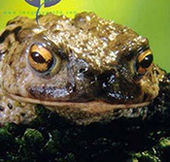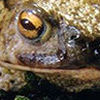Before it moved to its current location, the garden's compost heap used to be situated in a small brick-walled enclosure at the end of Millennium Shed. In summer 1999 I'd removed the carpet and the plastic sheeting and was about to stick the garden fork into the compost heap when I saw a creature looking up at me. I was a bit shocked, as I was only expecting worms and centipedes and woodlice, and not expecting anything with eyes.
Creatures in the compost heap
'A frog in the compost heap! Proper garden wildlife!' I thought, congratulating myself on having a wildlife-friendly garden with new creatures apparently appearing all the time. I wondered where it had come from, and checked with my next door neighbour, who I knew had recently installed a pond and introduced frogspawn.
When I described the frog he said he didn't think it was one of his, as his were only tiny as yet, and this one I realised was rather larger than the few centimeters he was indicating.
I saw it in various points in the garden, as over the summer there was plenty of vegetation for it to hide in, and it seemed to be wandering about happily near the walls, particularly those where the ivy formed thick cover.
Those of you who know your wildlife stuff will probably have guessed by now that this wasn't a frog, it was a toad.
Amphibian embarrassment
I was a little embarrassed when I had to tell the next-door neighbour and all the other people I'd excitedly told about the 'frog' that I'd got the wrong amphibian. I only found out my error when the visiting beekeeper suggested it might be a toad, and I went to look it up in a reference book.
The reference book I had to hand was the one I'd had since childhood: The Observer's Book of Wild Animals of the British Isles, published in the mid 1960s. The section on `The Common Toad' begins:
'Though in general terms the Toad may be said to be of similar form to the Frog, there is no need for a very minute catalogue of differences to enable the observer to discriminate between the two. So well known by sight are both amphibians that the majority of persons know them by their correct names on a casual glance; yet some may confuse them, and for this minority it is well to give some of the Toad's points.'
There I am firmly placed in the minority then - wouldn't be the first time . .
Maybe there were a lot more frogs and toads around in the 60s when that was written, but I didn't think I'd ever met one before.
Bufo the Slug Slayer
The Latin name is given as 'Bufo bufo' (so good they named it twice). So to make up for being such an ignoramus I then named it `Bufo' and greeted it warmly by name every time we met.
I realised its 'base' was the compost heap, and so turning the compost was a problem, until I'd located it. After our initial surprise meeting, the next time I needed to turn the compost I located it first, and let it move into the far corner and sit on the low wall. We spent a happy half hour with me emptying and restacking the compost pile, and the toad looking rather pleased that all these woodlice were appearing. I grew quite fond of it, watching it sitting there, all toadlike, looking down the wall, its beady eye on the woodlice.
I believe toads eat slugs, which seems quite heroic of them, and makes them certainly The Gardener's Friend.
Pond memories
It seemed to disappear, and I haven't seen it around the garden in the years since. As I'd been gardening here for a couple of years before it appeared, I don't know why it was here when it was, or why it disappeared again. My neighbour, in that initial conversation about 'the frog', told me that the previous owner had found frogs would come into the garden as there used to be a pond here once.
My Observer's book indicates to me that toads that go back 'to the identical pond in which they first saw the light', so maybe the previous owner was confusing her frogs and her toads, as I did.
I also read that a toad needs a fair depth of water to spawn in. I felt bad for the toad/frog that was looking for a lost pond, so I tried to create one. Available space meant this was more of a suggestion of a pond, a mini-pondette. I was quite pleased with the look of it, but it wouldn't be any use to a toad that wanted to spawn. In any case the toad was missing another vital component for this: another toad.
Maybe the lonesome toad went off somewhere and found a mate. I hope so.
Links
For confused people in that 'minority' with me, the following links will help you understand more about toads.
BBC Nature Wildfacts: Common toad : very useful

Photo, above and left: Common toad
(Bufo
Bufo).
©Peter Parks/ imagequest3d.com.
By kind permission
of
www.imagequest3d.com.

